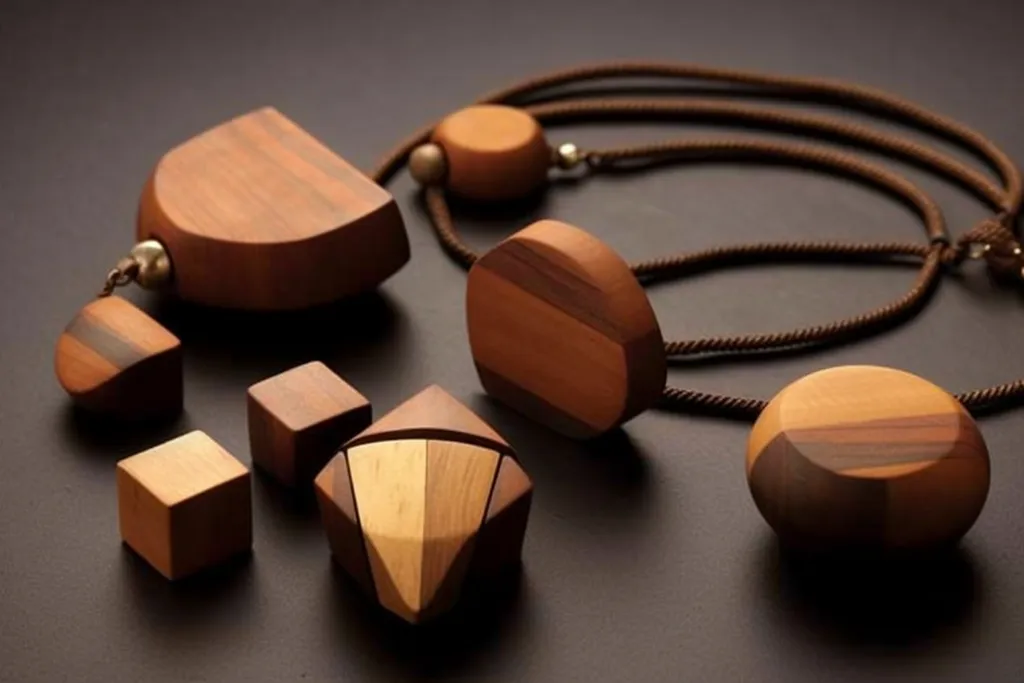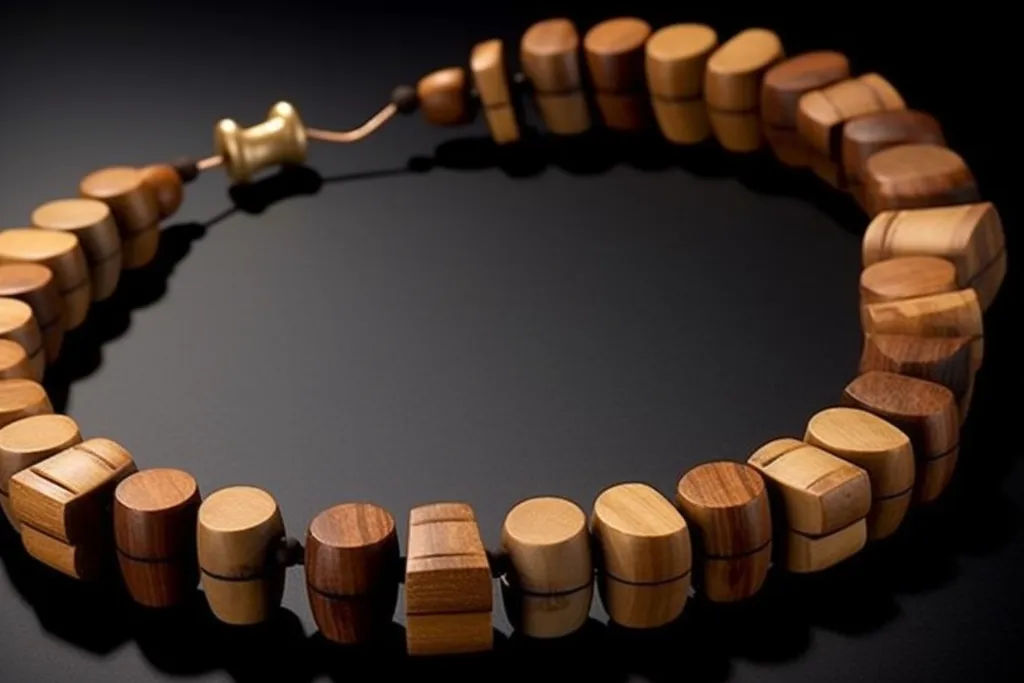Wood has been used in jewelry design for centuries, from ancient tribal adornments to modern pieces that incorporate wood with other materials. In recent years, wood has become increasingly popular in modern jewelry design, providing unique and innovative pieces that stand out from the crowd. From statement necklaces to minimalist earrings, wood offers versatility and sustainability to jewelry designers. In this post, we will explore the various ways that wood is being used in modern jewelry design.

Table of Contents
Types of Wood Used in Jewelry Design
In jewelry design, wood types such as mahogany, ebony, teak, and olive wood offer a range of unique textures, colors, and grains. Each wood type has its own distinct aesthetic that can be combined with other materials to create one-of-a-kind jewelry pieces.
Mahogany, renowned for its deep, warm color and smooth texture, is commonly used in furniture and musical instruments. In jewelry design, it adds a touch of elegance. On the other hand, ebony, with its striking black color and fine grain, finds its place in high-end furniture and decorative objects. In jewelry, ebony exudes sophistication.
Teak, characterized by its golden-brown hue, is highly valued for its durability and resistance to water damage, making it a preferred choice for outdoor furniture and boat building. Olive wood, known for its lighter color and captivating grain, often seen in kitchen utensils and decorative objects, brings unique color and texture to jewelry designs.
Techniques Used in Wood Jewelry Design
Designers can manipulate wood in various ways to create a variety of shapes and designs. They utilize techniques such as carving, sanding, and laser cutting to craft intricate details and patterns in wood jewelry. Combining these techniques with other materials such as metal and resin can result in stunning and one-of-a-kind pieces.
Carving is a traditional technique that involves using sharp tools to remove wood from the surface of a piece. This technique allows for intricate designs to be created, such as filigree patterns and detailed landscapes. Sanding, on the other hand, involves using sandpaper to smooth and shape the surface of the wood. This technique can create a variety of textures, from a smooth, polished surface to a rough, rustic finish.
Laser cutting is a more modern technique that uses a laser to cut and engrave wood. This technique enables craftsmen to create precise and intricate designs quickly and efficiently. Laser cutting finds application in crafting detailed patterns and designs in wood jewelry, as well as adding text and other embellishments.
Sustainability of Wood in Jewelry Design
Wood is a sustainable material that can be sourced from responsibly managed forests. Using wood in jewelry design reduces the need for non-renewable materials and can have a lower carbon footprint. By choosing wood jewelry, consumers can support sustainable practices and ethical sourcing.

It is important to note that not all wood used in jewelry design is sustainable. Over-harvesting and illegal logging practices have endangered certain woods, including rosewood and ebony. When buying wood jewelry, it is crucial to actively seek out pieces crafted from sustainably sourced wood or reclaimed wood to support responsible practices and conservation efforts.
Popular Wood Jewelry Designs
Wood has captivated jewelry designers, inspiring a wide range of captivating designs that cater to various styles. From rustic and bohemian to modern and minimalist, wood jewelry offers something for everyone. Here are some noteworthy examples of popular wood jewelry designs:
- Statement Necklaces:
Craftsmen skillfully craft the wood into bold and eye-catching necklaces. These pieces make a striking focal point for any outfit, effortlessly blending natural elements with artistic flair. - Wooden Cuff Bracelets:
Cuff bracelets made from wood showcase a remarkable blend of elegance and earthiness. With their wide design and intricate woodwork, these bracelets exude a unique charm that complements both casual and formal attire. - Geometric Earrings:
Artisans expertly shape wood into geometric forms, creating stunning earrings. These designs often boast clean lines and contemporary aesthetics, offering a modern twist to traditional materials.
– The Beauty of Upcycled Glass in Jewelry Making
– The Future of Jewelry Making: Biodegradable Materials
Rustic and Bohemian Wood Jewelry
Embracing a natural and free-spirited vibe, rustic and bohemian wood jewelry showcases the enchanting allure of organic shapes. Wood jewelry designers intricately incorporate tree branches, leaves, and other nature-inspired motifs. They frequently combine these pieces with complementary materials like leather and feathers, creating a perfect choice for bohemian festivals and outdoor events.
Modern and Minimalist Wood Jewelry
Embodying simplicity and sophistication, modern and minimalist wood jewelry presents clean lines and refined elegance. Geometric shapes take center stage, enhanced by the fusion of wood with other materials such as metal and resin. These designs are ideal for adding a touch of contemporary style to everyday wear.
Whether you prefer the rustic bohemian allure or the sleek minimalism, wood jewelry designs offer a distinctive touch that sets you apart. Express your personal style with these captivating pieces that combine the beauty of nature with artistic craftsmanship.
Care and Maintenance of Wood Jewelry
Proper care and maintenance are essential to prolonging the life of your precious wood jewelry. To ensure its longevity, follow these important guidelines:
- Storage: Store wood jewelry in a cool and dry place, away from direct sunlight. This helps prevent exposure to excessive heat or moisture, which can lead to damage.
- Conditioning: Regularly condition the wood by applying a thin layer of oil or wax. This helps nourish and protect the wood, preventing cracking and splitting over time. Choose a natural and suitable product for wood jewelry.
- Avoid Water Exposure: Never expose wood jewelry to water. Water can seep into the wood, leading to warping and potentially irreversible damage. It’s crucial to remove wood jewelry before engaging in water-related activities.
- Cleaning: When cleaning your wood jewelry, take caution to preserve its beauty and integrity. Use a soft, damp cloth to gently wipe the surface, removing any dirt or debris. Avoid using harsh chemicals or abrasive materials, as they can scratch or harm the wood.
- Drying: After cleaning, thoroughly dry the wood jewelry with a clean and soft cloth. Ensure it is completely dry before storing it to prevent moisture-related issues.
By following these care instructions, you can enjoy your wood jewelry for years to come, preserving its natural beauty and uniqueness.
FAQ
What types of wood are best for jewelry design?
Can wood jewelry get wet?
How do I clean my wood jewelry?
Is wood jewelry hypoallergenic?
Are there any special considerations when wearing wood jewelry?
Conclusion
Wood has become a popular and sustainable material in modern jewelry design, offering unique and innovative pieces. By exploring the different types of wood, techniques, and designs used in wood jewelry, consumers can find a piece that fits their personal style. With proper care and maintenance, wood jewelry can be a long-lasting and environmentally conscious addition to any jewelry collection.
